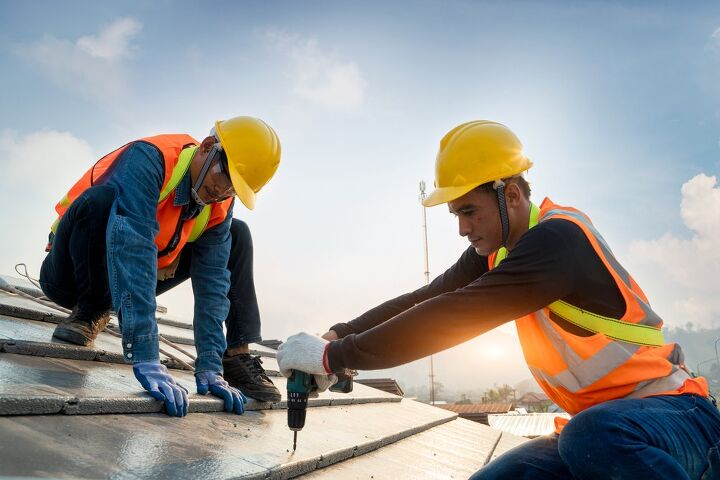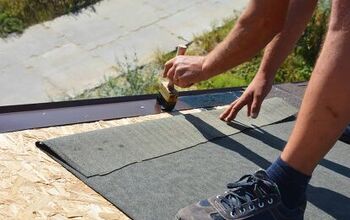Replacing The Underlayment Of A Concrete Tile Roof?

A tile roof can be a gorgeous addition to your home that adds curb appeal and provides long-lasting protection. In fact, tile roofs are the ideal choice for harsh desert environments as they are incredibly resilient against direct sunlight, heat, and the occasional summer storm.
However, over time these same harsh climates can take a toll on the concrete tile roof’s underlayment. The underlayment, or underlay, is necessary to provide ample protection against moisture intrusion, as the tiles themselves are not designed as a waterproof covering. This layer of material that exists between the tile and the roof deck is essential to the proper functionality of your roof. Your underlayment, along with the overlapping and interlocking concrete tiles are a complete water-resistant system.
Understanding the lifespan and cost of your underlayment is essential knowledge for when the time comes around for replacement. We’ve outlined all of the necessary information you should be aware of for replacing the underlayment of a concrete tile roof.
Do You Need Roofing Repair Services?
Get free, zero-commitment quotes from pro contractors near you.

Concrete Tile Roof Anatomy
When compared to other types of roofs, concrete tile roofs have a much more sophisticated design. For a tile roof to last, it must have the ability to bear the extensive weight of its tiles through a variety of climates and weather conditions. Because of this, tile roofs have more regulations placed on them than your standard asphalt shingle roof.
The International Residential Code (IRC) recommends that concrete tile roofs have a minimum pitch of 2.5:1 and requires at least a 30-pound felt underlayment under the tiles. Although, many contractors and architects favor a 60- or 90-pound underlayment that is secured with gasket nails.
The anatomy of a concrete tile roof involves the roof deck, underlay, battens, fasteners, and finally the tiles themselves. The roof deck is a layer of material that serves as both a barrier from the elements and endures the load of the roof’s other components. This part of a tile roof is the foundation and the underlayment exists above it.
The underlay is generally made of a synthetic material and provides waterproofing for the roof. The anchors for the various fasteners that hold the tiles are thin pieces of material, or battens, that are laid across the underlayment. Finally, you have the tiles themselves attached to these fasteners across the entire roof.
How Long Does a Concrete Tile Roof Last?
Although the lifespan of a concrete tile roof varies based on how well it is maintained, it can last 50 years or more under optimal conditions. As an added benefit, they are also a relatively inexpensive choice for a roof. With the proper maintenance, your concrete tile roof could virtually last a lifetime. However, there are factors that have a direct impact on reducing its overall lifespan. These include:
- Birds: Although birds themselves are harmless to your roof, their droppings can deteriorate concrete tiles when they are left to sit on them for an extended period of time. Bird droppings contain high levels of uric acid, which can weaken the structural integrity of your tiles.
- Leaves and debris: When leaves and other debris collect on your roof they can form water dams. Over time, these water dams will weaken your tiles and/or the supports underneath.
- Storms: Inclement weather conditions can knock branches or entire trees onto your roof. These large pieces can damage your concrete tiles or other parts of your roofing system.
Like anything, concrete tiles need the proper care for them to last their anticipated lifespan. However, the most vulnerable part of your concrete tile roof is the underlayment.
What is The Lifespan of a Concrete Tile Roof’s Underlayment?
While the concrete tiles are designed to filter water away from your roof, the underlay is what actually prevents leaks. Unfortunately, your concrete tile roof’s underlayment will deteriorate over time, especially in areas with rapid temperature changes.
How long your roof’s underlayment lasts will depend on the conditions it is exposed to and what it is made of. When compared to the tiles themselves, the underlayment typically has a much shorter lifespan. This means that, more or less, you will eventually have to replace the underlayment of your concrete roof.
Some of the factors that can reduce the lifecycle of your roof’s underlayment include extreme cold and heat, physical damage from debris, and pests. Once your underlayment fails, the water-tight seal is broken and your roof can suffer significant water and structural damage. Here are the most common underlayment materials and their associated lifespans:
- Asphalt Felt: This is the most widely used and oldest material for roof underlayment. It generally lasts between 20 to 30 years, but in extreme cases can last as little as eight.
- Synthetic or Rubberized Asphalt: These materials are much newer, more durable, and offer better protection against water infiltration. With regular inspections, synthetic and rubberized asphalt underlayments will last 25 years or more.
When it comes to your concrete tile roof’s underlayment, you should schedule inspections every 3 to 5 years. This will help you to get ahead of any possible damage and maximize its lifespan.
How Much Does It Cost to Replace the Underlayment of a Concrete Tile Roof?
If you’ve determined that it’s time to replace the underlayment of your concrete roof, this is likely one of the first questions you’ll ask. The cost for replacement depends on a few factors, including:
- The underlayment’s current condition
- The intricacy of your concrete tile roof
- The number of tiles that will require replacement in the process
The estimate for replacing a concrete tile roof is generally based on squares, or 100 square feet. Regardless of the complexity of your replacement, you should plan on losing between 10-15% of your tiles. When you’re calculating your budget, you should also add an additional 10% in the case of any unexpected expenses along the way.
The national average for replacing one square of the underlayment of a concrete roof ranges between $67 and $82. When you factor in the costs for labor if you plan on hiring a certified professional, the full price for replacing the underlayment rises to anywhere from $360 to $510 per square. Keep in mind that costs can increase based on the complexity of your roof and if you have any broken or absent tiles during the install.
Signs You Need to Replace Your Underlayment
Tile roofs can be tricky and knowing when it’s time to replace your underlayment is especially difficult since it is hidden by the tile. The best way to stay ahead of damage is to have regular roof inspections done by a professional. However, if you want to perform frequent inspections yourself, there are some things you can look out for that indicate your underlayment needs replacing.
The clearest sign that your underlayment may need replacing is if you’re experiencing roof leaks. If this is the case, professionals look for signs that the underlayment has become brittle, or is dried out, curling, or shrinking. If your underlayment is in good condition but you still have leaks, it’s possible that it was not initially installed correctly.
Over time, underlayment will shrink due to heat exposure and if improper overlap was done during install, it is rendered virtually useless. If water leaks aren’t easily visible, another thing to look out for is water staining on the eaves of your roof. If you notice water stains, this is a good sign that water is settling underneath your roof system and your underlayment is defective or damaged.
If you do not have exposed eaves on your roof, you can check for water staining in your attic. Simply use a flashlight to inspect the ceiling of your roof for any possible water infiltration caused by a faulty tile roof underlayment.
Do You Need Roofing Repair Services?
Get free, zero-commitment quotes from pro contractors near you.

Wrapping It Up
Although concrete tile roofs have a much higher upfront cost and can be rather costly to repair, they offer a lifetime of protection and appeal. Since the underlayment of a concrete tile roof has a much shorter lifespan than the tiles themselves, you should factor this into your decision about buying a home with a tile roof or upgrading your current one. While tile can certainly last several decades, you need to keep up with maintenance and repairs in order to reap all of the benefits.

Jessica considers herself a home improvement and design enthusiast. She grew up surrounded by constant home improvement projects and owes most of what she knows to helping her dad renovate her childhood home. Being a Los Angeles resident, Jessica spends a lot of her time looking for her next DIY project and sharing her love for home design.
More by Jessica Stone



























